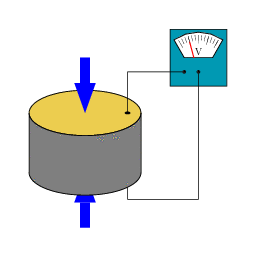Piezoelectric sensor facts for kids
A piezoelectric sensor is a device that uses the piezoelectric effect to measure changes in pressure, acceleration, temperature, strain, or force by converting them to an electrical charge. The prefix piezo- is Greek for 'press' or 'squeeze'.
Applications
Piezoelectric sensors are versatile tools for the measurement of various processes. They are used for quality assurance, process control, and for research and development in many industries. Pierre Curie discovered the piezoelectric effect in 1880, but only in the 1950s did manufacturers begin to use the piezoelectric effect in industrial sensing applications. Since then, this measuring principle has been increasingly used, and has become a mature technology with excellent inherent reliability.
They have been successfully used in various applications, such as in medical, aerospace, nuclear instrumentation, and as a tilt sensor in consumer electronics or a pressure sensor in the touch pads of mobile phones. In the automotive industry, piezoelectric elements are used to monitor combustion when developing internal combustion engines. The sensors are either directly mounted into additional holes into the cylinder head or the spark/glow plug is equipped with a built-in miniature piezoelectric sensor.
Sensing materials
Three main groups of materials are used for piezoelectric sensors: piezoelectric ceramics, single crystal materials and thin film piezoelectric materials. The ceramic materials (such as PZT ceramic) have a piezoelectric constant/sensitivity that is roughly two orders of magnitude higher than those of the natural single crystal materials and can be produced by inexpensive sintering processes. The piezoeffect in piezoceramics is "trained", so their high sensitivity degrades over time. This degradation is highly correlated with increased temperature.
The less-sensitive, natural, single-crystal materials (gallium phosphate, quartz, tourmaline) have a higher – when carefully handled, almost unlimited – long term stability. There are also new single-crystal materials commercially available such as Lead Magnesium Niobate-Lead Titanate (PMN-PT). These materials offer improved sensitivity over PZT but have a lower maximum operating temperature and are currently more complicated to manufacture due to four compound vs. three compound material PZT.
Thin film piezoelectric materials can be manufactured utilizing sputtering, CVD (Chemical vapour deposition), ALD (atomic layer epitaxy) etc. methods. Thin film piezoelectric materials are used in applications where high frequency (> 100 MHz) is utilised in the measurement method and/or small size is favored in the application.
Images for kids
See also
 In Spanish: Sensor piezoeléctrico para niños
In Spanish: Sensor piezoeléctrico para niños



